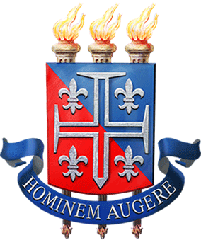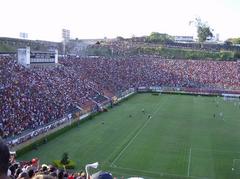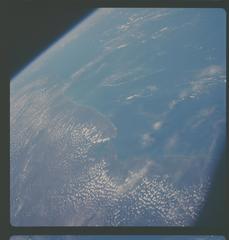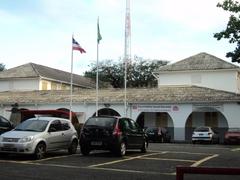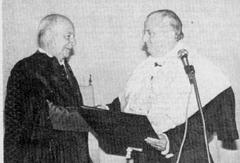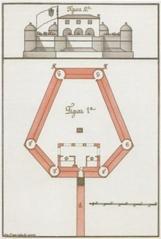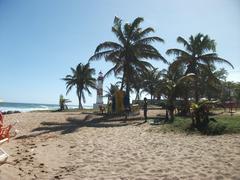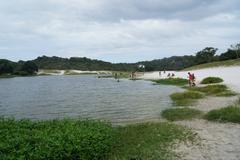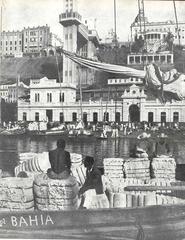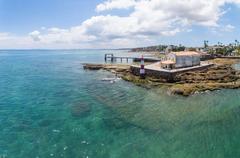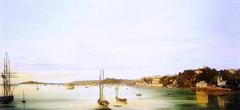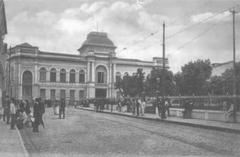
Forte de Santa Maria Salvador, Brazil: Visiting Hours, Tickets, and Historical Sites Guide
Date: 03/07/2025
Introduction
Forte de Santa Maria stands as an iconic monument on Salvador’s scenic coastline, encapsulating the city’s rich colonial past and military ingenuity. Erected in the early 17th century, this fortress was a pivotal stronghold during Portuguese colonial rule, safeguarding Salvador—then the capital of Brazil—against foreign incursions, particularly during Dutch-Portuguese conflicts. Today, Forte de Santa Maria is celebrated for its architectural artistry, cultural significance, and spectacular views of the Bay of All Saints, though as of 2025, it remains closed to the public for conservation (Colonial Voyage, Museu EXEA).
This comprehensive guide explores the fort’s history, design, and cultural legacy, while providing practical advice for visitors—including updates on visiting hours, ticketing, accessibility, and nearby attractions. Whether you are a history buff or a curious traveler, Forte de Santa Maria holds a central place in Salvador’s vibrant heritage.
Table of Contents
- Historical Overview
- Architectural Features
- Role in Colonial Defense and Dutch-Portuguese Conflicts
- Evolution and Restoration
- Integration with Salvador’s Defensive Network
- Cultural Significance and Modern Usage
- Visiting Information (Hours, Tickets, Accessibility)
- Nearby Attractions
- Frequently Asked Questions (FAQs)
- Conclusion & Travel Tips
- References
Historical Overview
Forte de Santa Maria’s origins date to the early 17th century, emerging from Portugal’s need to defend Salvador’s vital harbor from European rivals—most notably the Dutch, who launched several invasions in the 1620s and 1630s (Colonial Voyage, Museu EXEA). The fort was first constructed from wood and earth by Francisco de Frias, then rebuilt in stone and lime under Governor D. Diogo Luís de Oliveira’s administration (1627–1635). Its placement at Porto da Barra beach—a key point of entry to Salvador—was strategic, working in tandem with Forte de Santo Antônio da Barra and Forte de São Diégo to protect the city and its bustling port (WhichMuseum, Salvador History).
Architectural Features
The fort’s design is a testament to the Italianate military architecture that permeated Portuguese colonial defenses. Its compact, seven-sided polygonal layout was chosen to maximize fields of fire and minimize blind spots. Thick curtain walls, built to withstand naval bombardment and the coastal climate, are complemented by angled bastions and parapets constructed in the “barbette” style—allowing artillery to fire over the ramparts (bahia.ws).
A notable feature unique to Forte de Santa Maria is the inclusion of a firing stool for musketeers, increasing its defensive capability against infantry assaults. The entrance evolved from a drawbridge to a masonry bridge, reflecting advances in military engineering and changing defense strategies over the centuries.
Role in Colonial Defense and Dutch-Portuguese Conflicts
During the 17th century, Salvador was a prime target for Dutch forces eager to control Brazil’s lucrative sugar trade. Forte de Santa Maria played a vital role, especially during the Dutch occupation of 1624–1625 and the second invasion in 1638. As part of an integrated network of coastal defenses, the fort’s artillery and garrison contributed significantly to the city’s ability to repel invaders and maintain Portuguese control (Colonial Voyage).
Evolution and Restoration
Over successive decades, the fort underwent numerous modifications, particularly in 1696 under Governor General João de Lencastre and engineer José Pais Esteves. These renovations expanded covered areas, modernized artillery placements, and improved the internal layout. Restoration efforts in the 19th and 20th centuries sought to preserve the fort’s historical integrity, even as its military function waned (WhichMuseum, Wikipedia).
Photographic records and military plans from the 19th century confirm the fort’s enduring external appearance and strategic integration into Salvador’s urban landscape (bahia.ws).
Integration with Salvador’s Defensive Network
Forte de Santa Maria was never isolated; it functioned as a critical node within Salvador’s elaborate defense system. Its proximity to Forte de Santo Antônio da Barra and Forte de São Diégo allowed for coordinated artillery fire and rapid communication between garrisons. This networked approach was central to Portuguese military strategy, ensuring the protection of the harbor, city, and surrounding trade routes (Colonial Voyage, bahia.ws).
Cultural Significance and Modern Usage
Beyond its military function, Forte de Santa Maria is deeply embedded in Salvador’s social and cultural life. Its silhouette is a familiar landmark, featured in local art and photography, and its location near the historic landing of city founder Tomé de Souza in 1549 underscores its symbolic importance (WhichMuseum). The fort has hosted exhibitions such as “Mulheres e o Mar: Safira,” celebrating local maritime traditions and women’s roles in coastal culture (Museu EXEA).
Recognized as a national historic site since 1938 by IPHAN, the fort is also part of a proposed UNESCO World Heritage nomination for Atlantic maritime fortifications (Wikipedia).
Visiting Information (As of 2025)
Visiting Hours:
Currently closed to the public due to conservation challenges. For updates, consult Visit Salvador Bahia.
Tickets:
No tickets are available while the fort remains closed. Information on ticketing will be provided upon reopening.
Accessibility:
Historic structure and uneven terrain limit accessibility. Planned renovations aim to improve access in the future.
Getting There:
Located at Porto da Barra beach, Barra district, Salvador. Easily reached by public transport, taxi, or on foot from city centers.
Facilities:
Visitor amenities are currently unavailable due to closure. The site’s elevated position offers panoramic bay views, making it a popular spot for photography from the outside.
Nearby Attractions
- Forte de Santo Antônio da Barra (Barra Lighthouse): Another historic fort and one of Salvador’s most recognizable landmarks.
- Forte de São Diégo: Located nearby, often open to the public with exhibitions and cultural events.
- Porto da Barra Beach: A vibrant area for swimming, sunbathing, and experiencing Bahian cuisine.
- Pelourinho District: Salvador’s UNESCO-listed historic center, rich in colonial architecture, museums, and churches.
Frequently Asked Questions (FAQs)
Q: What are Forte de Santa Maria’s visiting hours?
A: The fort is closed to visitors as of 2025. Check official sources for updates on reopening.
Q: Are tickets required?
A: Tickets are not available while the fort is closed. Future ticketing details will be shared upon reopening.
Q: Is the fort accessible for people with disabilities?
A: Accessibility is limited due to the historic structure, but future renovations aim to address this.
Q: How do I get to Forte de Santa Maria?
A: The fort is at Porto da Barra beach, easily accessible via public transport, taxi, or on foot.
Q: Are guided tours available?
A: Guided tours will resume when the fort reopens. Check local tourism resources for updates.
Conclusion & Travel Tips
Forte de Santa Maria is a powerful symbol of Salvador’s colonial resilience, maritime heritage, and architectural ingenuity. Its storied past, strategic design, and scenic coastal setting make it an essential destination for history lovers and cultural explorers. While the fort is temporarily closed for conservation, its legacy endures, and visitors can still appreciate its striking presence from the nearby beach and promenade.
Travel Tips:
- Combine an external visit to Forte de Santa Maria with walks along Porto da Barra and visits to neighboring forts.
- Stay informed about reopening and event schedules by checking Visit Salvador Bahia and related heritage sites.
- For in-depth exploration, download the Audiala app and follow us on social media for the latest travel updates and cultural insights.
References
- Colonial Voyage – Forts of Salvador, Bahia
- Museu EXEA – Forte de Santa Maria
- WhichMuseum – Forte de Santa Maria Salvador
- Wikipedia – Forte de Santa Maria
- Salvador History – Things to Do in Salvador Brazil
- Tourb – Forte de Santa Maria
- Bahia.ws – Defenses of Porto da Barra: Forts of Santa Maria and São Diogo
- Visit Salvador Bahia – Official Tourism Site
For more travel guides and heritage site updates, download the Audiala app and follow us on social media. Explore related articles on Salvador’s colonial forts and discover Bahia’s hidden gems!



